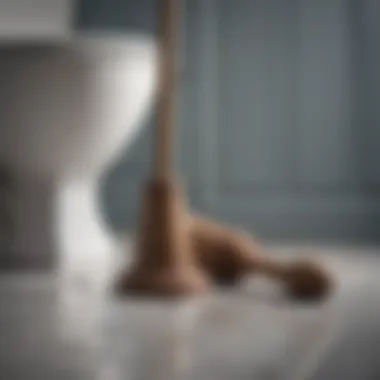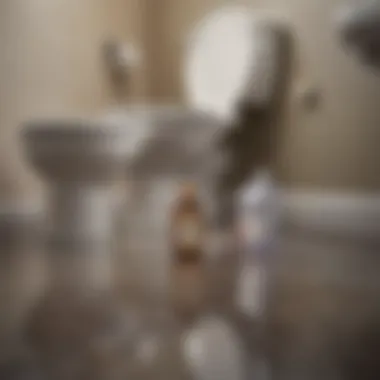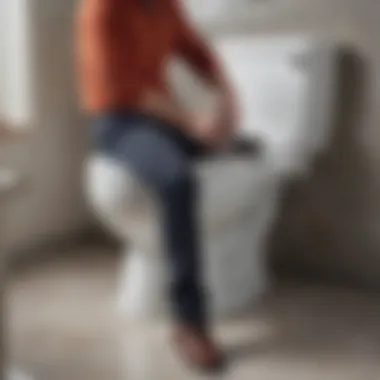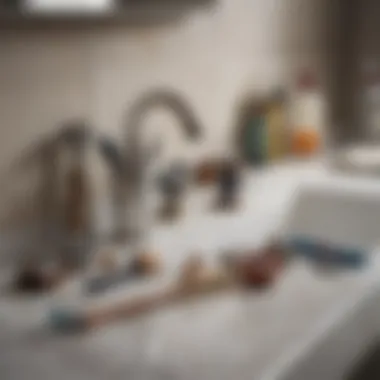Mastering Toilet Clogs: DIY Solutions for Homeowners


Intro
Clogged toilets are frequent issues in many homes. Most homeowners face the dilemma of whether to attempt a repair or call a plumber. Understanding how to unclog a toilet without stepping foot into a professional's tool kit is essential. This knowledge not only saves money but also empowers individuals to take control of minor plumbing problems. Throughout this guide, practical methods will be discussed, instilling confidence in tackling toilet clogs effectively.
Methods to Unclog a Toilet
Using a Plunger
A plunger is a basic yet effective tool in addressing clogs. It creates pressure to move unwanted materials down the drain. Follow these steps:
- Make sure the toilet has some water in the bowl; if it's too low, add water for a good seal.
- Place the plunger directly over the drain hole.
- Push down gently to remove any air and then pull up sharply.
- Repeat this action for around 15-20 seconds.
If done correctly, the clog may clear itself, allowing normal function to resume.
Basic Home Remedies
Sometimes harsh chemicals aren’t necessary. Simple household products can also solve the issue. Baking soda and vinegar can be quite effective against clogs:
- Pour one cup of baking soda into the bowl.
- Follow with one cup of vinegar.
- Let the mixture sit for at least 30 minutes, ideally longer.
- Flush the toilet.
The chemical reaction may help dissolve the clog.
Additional Tools to Consider
If neither the plunger nor home remedies work, using a toilet auger might be the answer. A toilet auger has a flexible rod and a corkscrew end designed to break through tough clogs:
- Insert the auger into the toilet’s drain while gently turning the handle.
- Push the auger forward until you feel resistance.
- Rotate the handle to loosen or attach the clog material.
Plungers and home remedies can often manage many clogs; knowledge of additional tools serves as a fallback option.
When to Call a Professional
Should these methods fail, assessing the situation becomes critical. Permanent plumbing issues may need an expert's eye. Persistent clogs despite following these steps can indicate more extensive piping troubles requiring specialist intervention.
"Knowing how to manage basic home repairs can save time and increases the confidence to tackle future issues."
The End
Independent plumbing taps into personal competence. Every homeowner can become adept at unclogging a toilet without a plumber's help. Savvy techniques, resourcefulness, and some practice guide successful travel down someone’s bathroom mishaps.
Foreword to Toilet Clogs
The subject of toilet clogs is more than just a nuisance for homeowners. Understanding the ins and outs of this common issue provides a certain level of confidence in home maintenance. Many people experience toilet clogs at some point. The importance of addressing this concern is paramount. It not only affects the flow of daily life, but also ties into broader themes of self-sufficiency and home responsibility.
Properly grasping the basic causes and consequences of toilet clogs will empower individuals to resolve problems as they arise. Knowing the fundamentals equips homeowners to act quickly and effectively. Addressing toilets clogs means less reliance on professionals, which can lead to notable savings. It cultivates a proactive attitude towards home upkeep, allowing individuals to foster a can-do mindset.
Understanding Common Causes


Clogs often arise from various scenarios, and recognizing these common reasons can assist in prevention. One leading cause is the excessive use of toilet paper. Individuals may mistakenly think that more paper leads to a more thorough clean, but in reality, this can have the opposite effect.
Another factor is foreign objects, which may inadvertently become lodged in the toilet. This is especially common in households with young children, who may flush toys or other items without understanding the consequences. Lastly, narrower pipes or plumbing angles can contribute to blockages. Thus, knowing these triggers enhances one's ability to take corrective measures before a major blockage occurs.
Common causes of toilet clogs include:
- Excessive toilet paper usage
- Flushing foreign objects
- Structural issues with plumbing
Identifying the Severity of the Clog
Not all toilet clogs are created equal, and distinguishing the severity can guide appropriate action. A mild clog may allow for a normal flush without any overflow but might create slow draining. On the other hand, a severe clog can cause backflow or prevent the toilet from functioning altogether.
Check indicators first. If water is not draining or you're experiencing bubbling noises, consider these signs a significant issue. Understanding the obstruction’s impact on both daily activities and plumbing systems will influence the method of resolution. In some cases, quick action can prevent more extensive and costly repairs down the line. Knowing the appropriate reaction based on the severity will ultimately save time and financial resources for the homeowner.
Essential Tools for Unclogging
Having the appropriate tools is essential when it comes to effectively unclogging a toilet. The right instruments will not only save time but also enhance the overall success in resolving the issue. Investing a little in these tools can prevent more significant problems in the future, ultimately leading to money and effort savings. This section explains key tools and their relevance for homeowners.
Choosing the Right Plunger
Choosing the right plumber is decisive in addressing toilet clogs. A standard cup plunger might not suffice for a toilet. Instead, a flange plunger, which has a rubber flap around the bell-shaped top, is preferred. Its design fits better with the toilet bowl's drain and can create a stronger seal. This strength often translates to better suction, improving clog removal. They are found easily at hardware stores.
When selecting a plunger, consider the following:
- Material: Rubber plungers tend to work best. They remain pliable and maintain their effectiveness.
- Cost: Invest in quality; a few dollars more can lead to better outcomes.
- Ease of Use: Ensure it is comfortable to handle, especially when pressure is applied.
In proper hands, the right plunger can be remarkably effective in tackling blockage without too much hassle.
Alternative Tools Available
When plungers do not creates the desired result, alternative tools can become essential. Understanding these can expand a homeowner’s capability to address clogs effectively.
Here are a few valuable alternatives:
- Toilet Auger: Also known as a closet auger, this specialized tool is great in clearing stubborn clogs deep in the toilet’s trap. It’s a flexible metal cable with a rotating head that can break and pull out the obstruction.
- Wet/Dry Vacuum: This versatile tool can serve multiple purposes. If you're comfortable with this method, configure the vacuum to pick up liquid safely. Place it over the drain and create a vacuum seal to extract the water along with any blockage.
- Zip-it or Plumbing Snake: A plumbing snake consists of a long, flexible device that can navigate through bends after the toilet. It can break apart or retrieve obstructions efficiently.
Each tool has its specific use-case scenarios. It's prudent to experiment and determine which one serves your plumbing needs the best.
Using a Plunger Effectively
Using a plunger correctement is crucial for unclogging toilets effectively. This method, while basic, provides significant benefits because it is readily accessible and easy to learn. A well-executed plunging technique can resolve most minor clogs, saving time and minimizing frustration. Understanding how to use a plunger not only empowers DIY enthusiasts but also enhances one's overall plumbing knowledge and skills.
Preparation Steps
Before plunging begins, certain preparation steps can enhance success chances. First, gather necessary materials. Ensure you have the right type of plunger, preferably a flange plunger, as it is specifically designed for toilets. Protect the bathroom floor with towels in case of splashes. If necessary, wear gloves to maintain hygiene. Make sure to fill the toilet bowl with a sufficient water level. An effective plunge benefits from water that covers the rubber part of the plunger. This technique guarantees that pressure builds up, helping to push the clog through. If the water level is low, consider adding some to create optimal conditions for the unclogging process.
Plunging Technique
Plunging requires specific techniques to effectively clear clogs. First, position the plunger so its flange creates a tight seal around the toilet's drain hole. The angle matters; ensure the handle is straight. Start with slow and gentle thrusts to initiate water movement. After gaining momentum, gradually increase the force of plunging. It allows for effective pressure does not force water out instead of creating a productive motion. Continue this process for approximately 20 to 30 seconds, then remove the plunger. Observe the toilet. If the water starts decreasing effectively, you might have cleared the blockage. Always avoid sudden and harsh maneuvers to prevent toilet damage.


Post-Plunging Clean-Up
DIY Remedies for Minor Clogs
Dealing with toilet clogs can be frustrating. Many people turn to professionals at the first sign of trouble. However, minor clogs can often be resolved right in your home. Using DIY remedies is practical for those who want to avoid extra expenses. These methods are often quick, simple and do not require special tools or skills. Being able to resolve clogs independently provides a sense of self-sufficiency. This part of the guide will shed light on two effective DIY remedies commonly used: Baking Soda and Vinegar and Hot Water Treatment.
Baking Soda and Vinegar Method
The combination of baking soda and vinegar is a popular household remedy for many cleaning issues, clogs included. This method works due to the chemical reaction between the two ingredients, which produces carbon dioxide. When poured into the toilet, this reaction can help break down materials causing the clog.
Benefits of This Method:
- Natural Ingredients: Baking soda and vinegar are non-toxic and safe for your plumbing.
- Ease of Use: These items are typically found in most households.
- Effective Action: The bubbling action can free up minor blockages without physical effort.
Steps to Use It:
- Pour one cup of baking soda into the toilet bowl.
- Follow with one cup of vinegar.
- Let the mixture sit for about 30 minutes.
- Finally, flush the toilet to see if the clog is gone.
If necessary, you can repeat the process for persistent issues. It can be surprising how effective simple materials can be.
Hot Water Treatment
Hot water can work wonders on minor clogs. This is a simple and often overlooked method. The heat can dissolve residual material that contributes to obstructions. Hot water treatment might be more effective if combined with other methods as well.
Key Considerations:
- Temperature: Do not use boiling water as it can crack porcelain.
- Clog Nature: This method works best for minor clogs caused by soap residue or oils.
How to Apply This Method:
- Heat water in a kettle. Keep the water hot but not boiling, around 140°F (60°C).
- Slowly pour the hot water into the toilet bowl from waist height.
- Allow it to sit for a few minutes.
- Flush the toilet and check if the clog is cleared.
When to Use a Toilet Auger
Toilet clogs can sometimes be more stubborn than a standard plunger can handle. At this juncture, understanding when to use a toilet auger becomes essential. This tool addresses deeper or more complicated clogs that are beyond the immediate reach of a plunger. Recognizing when to deploy this solution can prevent prolonged issues, property damage, or costly repairs.
A toilet auger offers multiple benefits. Most importantly, it is designed for elongated and narrow pipes like those found in toilets. While plungers effectively clear surface-level blockages, an auger can navigate through bends of the waste line. Furthermore, augers can often reduce the need for professional plumbing services, which can save considerable time and expense.
Be aware of specific conditions for when the auger should be employed:
- The plunger has not resolved the issue after several attempts.
- You notice water backing up into the bowl continuously, indicating a significant blockage.
- If there is an unusual odor associated with the clog, it may signify deeper issues that necessitate using an auger.
An auger operates through a flexible metal coil that can reachblockages in a way that standard tools cannot.
Understanding Toilet Augers
Toilet augers generally feature a steel cable wound within a protective tube. This tool often has a curved, bell-shaped head designed to break through clogs effectively without causing damage to the porcelain interior of the toilet. Hence, it is vital to learn about their functioning before getting into the installation phase. An auger uses a simple yet effective mechanism to push through blockages that obstruct the passage. This device can also retrieve toilet paper and other materials that could cause a clog.
It is invaluable to maintain this tool properly. Regular cleaning can prevent germs or bacteria trap inside the tube, making it safe and efficient for use. Augers do have a slight learning curve; familiarity will enhance their effectiveness.
Proper Auger Usage


Using a toilet auger correctly is critical for successful unclogging. Here are the essential steps to follow:
- Preparation: Position towels or a bucket under the toilet to catch any splashes. It helps in addressing the mess that can come about during this process.
- Inserting the Auger: Carefully place the auger’s bell-shaped tip into the toilet bowl's drainhole. Ensure it's aimed straight down.
- Cranking the Handle: Turn the handle to extend the coil. As you twist, you will likely feel resistance as it meets the clog. Slow but consistent pressure can often break through.
- Removing the Auger: After working through the obstruction, gently pull the auger out of the toilet while continuing to crank it. This action will aid in retraction while maintaining cleanliness.
- Final Inspection: Flush the toilet to ensure water flows freely. If any issues persist, it’s advisable to reassess the clog and repeat the augering process.
Mechanics of using an auger do take practice for victims of serious blockages. Flexibility and attention ensure damage remains impossible when successfully utilized.
Remember: Proper technique reduces the risk of damaging toilet components, ensuring longevity in your bathroom fixtures.
Knowing when to opt for a toilet auger and employing it properly is integral in maintaining your plumbing systems. Following these guidelines will maximize effectiveness and help keep unexpected clogs in check.
Preventive Measures to Avoid Clogs
Preventing toilet clogs is essential for maintaining a functioning bathroom and can save homeowners both time and money. Clogs can lead to backups, inconvenient situations, and the need for professional interventions. Employing preventive measures helps identify and maintain conditions that promote proper flow in your toilet system, ultimately enhancing its longevity while minimizing unnecessary headaches.
Regular Inspection and Maintenance
Conducting regular inspections and maintenance on your toilet is key to avoiding clogs. A toilet’s internal components, such as the flapper, chain, and fill valve, can wear out over time. Here are some steps for effective maintenance:
- Check the flapper regularly: The flapper could be leaking or not sealing properly. This can cause overflowing or issues with flushing.
- Flush Test: Perform a simple flush test. If the toilet takes unusually long to refill, there might be an issue that needs immediate attention.
- Purge bright pieces: Every few months, check for toilet paper accumulation or other debris that may hinder the function.
These routine inspections prevent the build-up of foreign materials, such as too much toilet paper or hygiene products, which often lead to blockages.
Educating Household Members
Education can play a vital role in preventing clogs. Many clogs arise from misuse or misunderstandings about what can be flushed down a toilet. It’s important to inform all household members about proper toilet use, including the following points:
- No flushing non-biodegradable items: Items such as wipes, cotton swabs, or napkins should never be flushed. Make sure there’s a proper waste management system in place.
- Limit toilet paper: Encourage everyone to use an appropriate amount of toilet paper. Using excessive paper can lead to buildup.
- General Communication: Maintain an open dialogue about any issues noticed with toilet use. Encourage people to report clogs immediately rather than ignore them.
Educating everyone in your home on these basics creates a collective responsibility towards toilet maintenance, effectively lowering the chance of encountering warns.
Regular checks and education are small investment that outweighs the costs associated with fixing severe clogs. Better safe than sorry.
End: The Value of Self-Sufficiency in Home Maintenance
In navigating the intricacies of toilet clogs, this guide underscores the profound significance of self-sufficiency in home maintenance. The ability to resolve plumbing issues independently not only alleviates immediate frustrations but also engenders a sense of empowerment in homeowners. Tackling clogs without resorting to a plumber cultivates problem-solving skills that extend to various facets of home ownership. Homeowners are not just passive observers in maintaining their living space; rather, they become active participants.
Adopting a hands-on approach reduces reliance on professionals. Bringing attention to preventive measures also allows for the avoidance of future issues. When homeowners educate themselves on the methods and tools available, it enhances confidence while tackling regular maintenance tasks. This skill set not only saves money but also builds a resilient mindset towards homeownership challenges.
Lastly, sharing knowledge within the household creates a communal ethic of care towards shared spaces. Achieving self-sufficiency through practical tools encourages collective responsibility and contributes to overall home harmony.
Empowering Homeowners
Empowerment in this narrative emerges as a pivotal theme. Homeowners who grasp effective plumbing techniques realize that many fixes are within their reach. This realization transforms a potentially daunting task into an achievable goal.
- Enhanced skills: Familiarity with tools and methods builds confidence. When plumbing problems arise, individuals equipped with knowledge can rectify them quickly.
- Psychological relief: Successfully unclogging a toilet translates to more than just fixing an issue. Individuals take pride in their capability, leading to decreased anxiety about unexpected home maintenance tasks.
- Financial savings: A single plumbing visit can be costly. Learning how to resolve everyday issues saves both money and the frustrations that the longer waits usually involve.
Final Thoughts on Plumbing Skills
As we conclude the discussion on toilet maintenance, it is essential to reflect on the broader impact of plumbing skills within the home. Plumbng knowledge fosters resilience. Homeowners become adept at addressing minor crises that, if neglected, could evolve into larger, costlier problems.
This is not just about unclogging a toilet. It opens the door to a greater comfort level with all home repairs. As responsibilities grow, the skills learned emerge invaluable. Whether it is leaky faucets or stubborn drains, DIY capabilities are a vital tool in every homeowner's toolkit.
Embracing self-reliance ultimately contributes to a well-maintained living environment where individuals feel secure and competent. For homeowners seeking efficiency and effectiveness, mastery of basic plumbing skills should not be undervalued. In aiming for mastery in these methods, you secure a home that thrives in functionality and harmony.
Ultimately, being proactive in home maintenance allows individuals to turn unexpected challenges into manageable tasks, cementing their role as capable caretakers of their living spaces.



